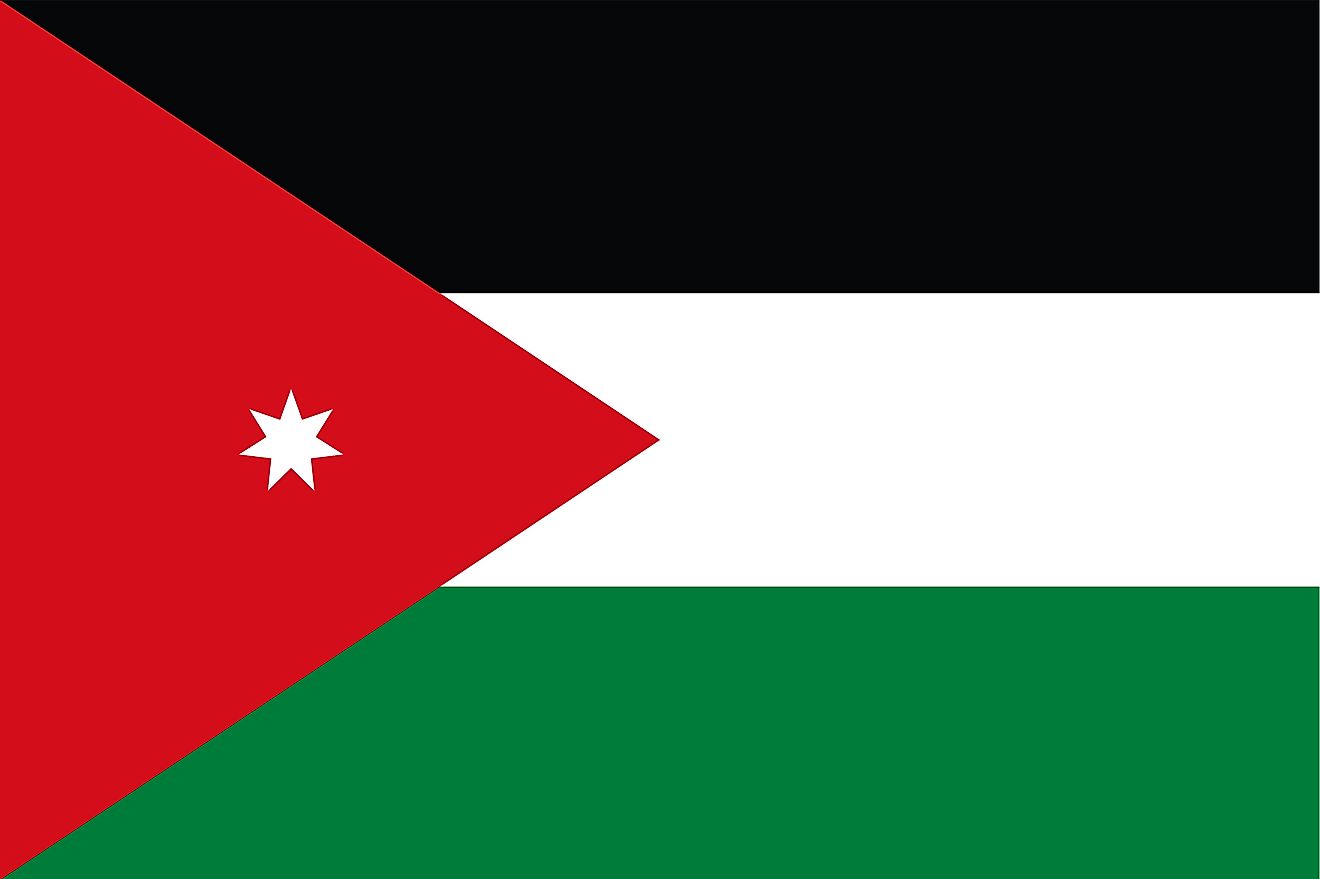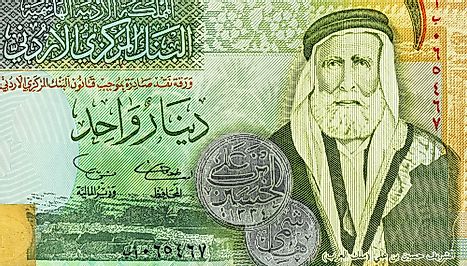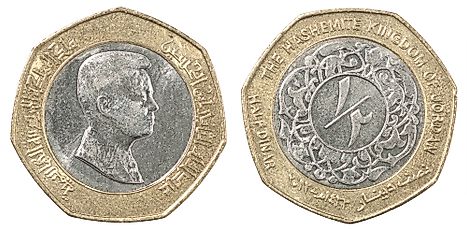Flags, Symbols, & Currencies of Jordan

The flag of Jordan was adopted formally on April 18, 1928. The flag consistsr of three horizontal bands and triangle with a star on the hoist, based on the flag of the Arab Revolt. The colors from the upper to the lower end of the flag are black, white, and green. The red chevron with its base on the hoist side of the flag contains a white seven-pointed star. The national flag of Jordan has a height to length proportion of 1:2.
Meaning of the Colors and Symbols
Every detail of the flag of the country is associated with a specific meaning. The design of the flag is based on the flag used by the revolutionaries during the Arab Revolt against the Ottoman Empire during the First World War. The three colors used in the flag are the Pan-Arab colors. Here, black represents the Abbasid, white represents the Umayyad, and green symbolizes the Fatimid caliphates. The current ruling dynasty of the Jordan, the Hashemite dynasty, is represented by the red chevron, which also represents the Great Arab Revolt of 1916. The star at the center of the chevron epitomizes the unity of the Arab people. The seven points on the star represent faith in One God, national spirit, humanity, national spirit, social justice, aspiration, and virtue.
History of the Flag
The current flag of Jordan is based on the Arab Revolt flag used during the fight against the Ottomans in World War I. The Arab Revolt flag featured three horizontal bands of black (top), green, and white, and a golden chevron with its base on the hoist side. However, the first flag of Jordan used between 1921 and 1928 altered the consisted of black-white-green horizontal band and a red chevron without the white star. In 1928, the 7-pointed white start was added to the red chevron and the flag adopted as an official symbol of Jordan
Symbols of Jordan
National Coat of Arms of Jordan

Jordan's coat of arms consists of a black eagle (symbolizing power, might and loftiness) standing on top of a bronze shield supported by two flags of Jordan, spears, swords and bows and arrows. Below the shield are two branches of wheat, a palm branch, and the decorative order of al-Nahda. The phrase depicted on the right of the al-Nahda reads, "Abdullah II bin Al Hussein bin Aoun," (Aoun, the great grandfather of Al Sharif Al Hussein bin Ali); in the middle, "King of the Hashemite Kingdom of Jordan," and to the left, "Who seeks support and guidance from God."
National Anthem
- Anthem Title: "as-Salām al-Malakī al-ʾUrdunī" (The Royal Anthem of the Hashemite Kingdom of Jordan)
- Music composer: Abdul al-Qādir al-Tanīr
- Lyricist: Abdel Munʿim al-Rifāʿī
- Date of Adoption: 1946
"as-Salām al-Malakī al-ʾUrdunī" is the national anthem of Jordan, adopted on May 25, 1946. The lyrics of the Royal Anthem of Jordan were written by Abdel Munʿim al-Rifāʿī, with Abdul al-Qādir al-Tanīr setting it to music. The first version of the anthem was one of the shortest anthems in the world, as it contained only the first stanza of the current version. However, the anthem has been expanded to include two extra stanzas and a chorus. The full version of the anthem is normally sung during special occassions.
السلام الملكي الأردني /as-Salām al-Malakī al-ʾUrdunī (Arabic)
عاش المليك
عاش المليك
ساميا مقامه
خافقات في المعالي أعلامه
٢
نحن أحرزنا المنى
يوم أحييت لنا
نهضة تحفزنا
تتسامى فوق هام الشهب
جوقة
يا مليك العرب
لك من خير نبي
شرف في النسب
حدثت عنه بطون الكتب
٣
الشباب الأمجد
جندك المجن
عزمه لا يخمد
فيه من معناك رمز الدأب
جوقة
٤
دمت نورا وهدى
في البرايا سيدا
هانئا ممجدا
تحت أعلامك مجد العرب
بجو
The Royal Anthem of the Hashemite Kingdom of Jordan
Long live the King!
Long live the King!
His position sublime,
His banners waving in glory supreme
We achieved our goal,
On the day you revived for us,
A revolution gives us our motivation!
Flying over the shoulders of the highest comets.
Chorus:
O king of Arabs,
From the best prophet you have.
The honour of dynasty,
Talked about in the depths of books!
All the youthful men,
Are your armed armies
His determination never dies out!
Getting from your meaning a symbol of well-being!
Chorus...
May you stay the light and the guide,
A master in being away of all sins and wrong-doing,
Living your life happily and well-respected!
Under your flying flag rests the glory of all Arabs.
Chorus....
The Currency of Jordan is the Jordanian dinar
The currency of Jordan is the Jordanian dinar. The official code used to refer to the Jordanian dinar is JOD, while the unofficial code is JD. Furthermore, its sign is دينار. Its minor units are: 1/1000 fils, 1/100 qirsh, and 1/10 dirham. The inflation rate is -0.80. It is important to note that the Central Bank of Jordan is responsible for the dinar's issuance and injection into the economy. The major foreign exchange in Jordan takes place between the dinar and euro currencies.
Coins
The government first introduced coins in 1949. They were circulated in denominations of 100, 50, 20, 10, 5, 1 fils. Other coins were issued later, such as the 20 fils in 1965, 25 fils in 1968, ¼ dinar in 1970, 1 fils in 1985, and smaller ¼, ½, and 1 dinar coins in 1996. 1 fils coin was last minted in 1985. The fils, qirsh and dirham coins were denominated using Arabic text until 1992. The coins were struck in brass, nickel, copper, aluminum, bronze, and cupronickel. Currently, the most frequently used coins are 50, 25, 10, 5, 2, and 1 fils.
Banknotes
The government of Jordan began issuing banknotes in 1949. The first denominations to be minted were 50, 10, 5, 1, ½ dinars. In 1959, the Central Bank of Jordan took over notes production from the Jordan Currency Board. The Central Bank introduced 20 and 50 dinar notes in 1977 and 1999, respectively. It replaced the ½ dinar notes with coins in 1999. The most frequently used Jordanian dinar bank notes are in denominations of 50, 20, 10, 5, and 1 dinar. The notes have been made of attractive colors such are blue, orange-brown, and light green among other colors.
Historical Currencies of Jordan
History of the Jordanian Dinar
Between the year 1927 and 1950, Jordan used the Palestine pound as its currency. When Jordan gained its independence in 1946, its was believed that the country should have its own national currency. This ultimately resulted in the passing of Provisional Act No. 35 of 1949, which paved the way for the creation of the Jordan Currency Board in 1949. Composed of four members and a president, the board was granted the sole responsibility of issuing the new Jordanian currency. The Jordanian dinar became Jordan’s official currency in 1950.














